

Explore the history, culture, people and beautiful landscapes of Vietnam on the 63Stravel travel app
Download the 63stravel app

When mentioning Son La, people will immediately think of scenic spots, poetic plum blossom seasons or immense tea hills. Not only that, this place exists and stores many historical relics in sacred and long-standing Son La. Join 63 Stravel to learn about famous historical sites in Son La!
Top 16+ most attractive historical sites in Son La for you to explore
Son La not only has beautiful tourist attractions but also many long-standing historical relics that many people come to explore. Below is a list of historical sites in Son La that you can save and experience if you have the opportunity to come here.
Ta Vai Bridge
Ta Vai Bridge, located in Ta Vai village, Chieng Hac commune, Yen Chau district, is a famous historical relic of the province. During the resistance war against the French and Americans, the bridge not only had significance for people's livelihood but was also an important traffic artery. During the war, Ta Vai bridge suffered 1,272 bombs from American aircraft but still stood firm, ensuring smooth traffic.
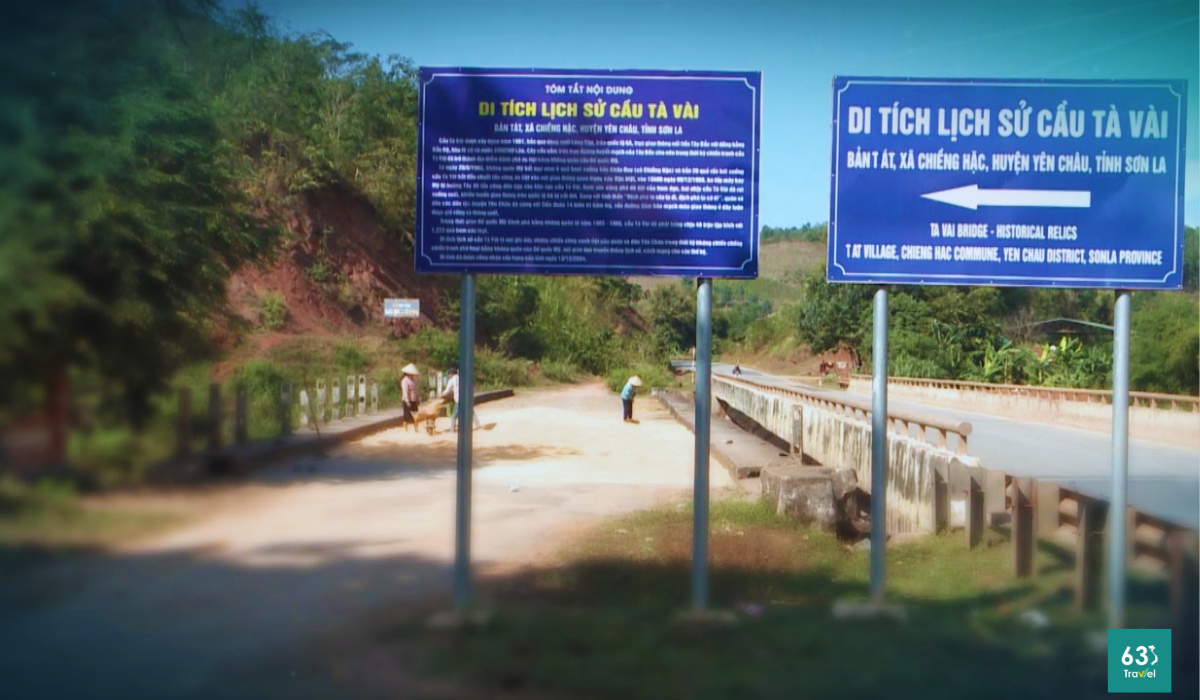
Ta Vai Bridge is a historical place in Son La
The fierce battle at Ta Vai bridge witnessed the resilience of the militia and self-defense forces and the army, determined to protect traffic arteries. From March to December 1966, the 14th Anti-aircraft Artillery Battalion, with the support of local people, arranged anti-aircraft artillery to protect the bridge. The solidarity and stubborn fighting spirit of the militia and soldiers have kept this vital road clear in all situations.
White Bridge historical site
The White Bridge historical relic is located on National Highway 6A (old Road 41), a bridge over Nam La stream, connecting the Northern Delta provinces with Son La, Dien Bien and Lai Chau. With a length of 45m and a width of 7m, White Bridge was designed and built in 1963, carrying strategic significance in the two resistance wars against the French and the Americans.
During the period 1965-1968, the White Bridge became a target for bombardment by the US Air Force, enduring 34 battles with 870 bombs and hundreds of rockets, causing the bridge to be completely destroyed. However, in 2003, the bridge was rebuilt with a modern design, 48.1 m long and 14 m wide and officially inaugurated in 2006.
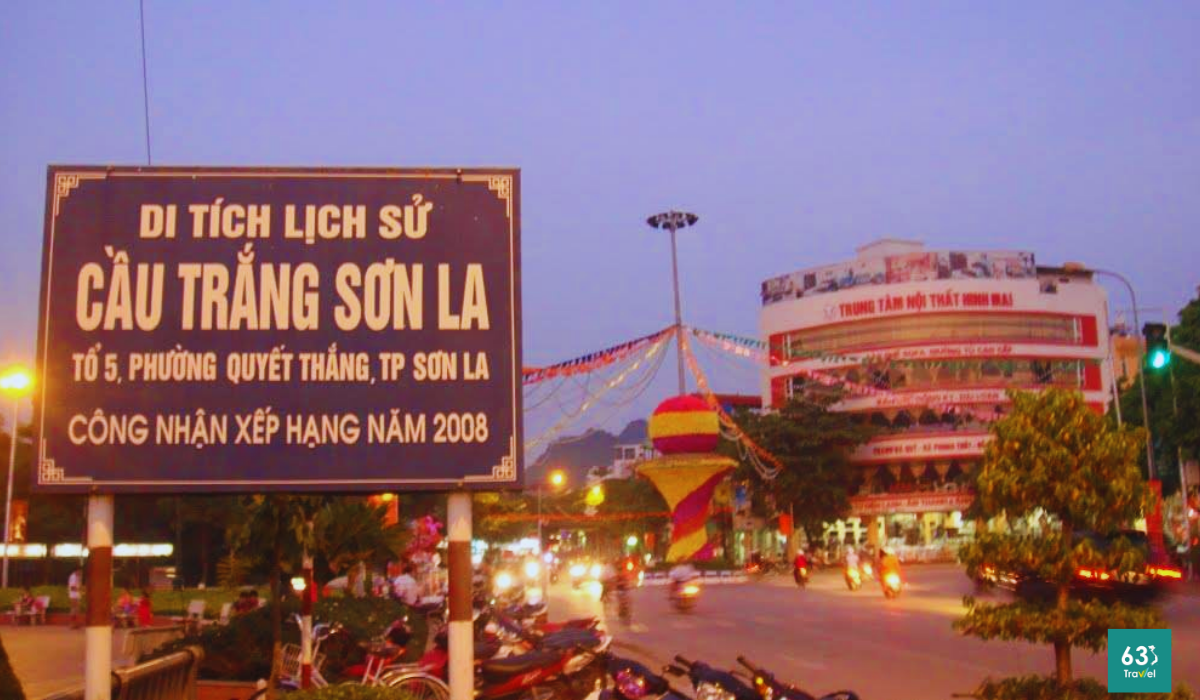
Famous White Bridge historical relic in Son La
The White Bridge is not only a historical witness of the resilience, solidarity and patriotism of Son La's army and people, but also evidence denouncing the crimes of American imperialism. This place marks typical faces such as national emulation soldier Nguyen Kim Tien, who contributed to ensuring smooth traffic, transporting food and weapons to the Northwest and Upper Laos.
Walking on the White Bridge today, feeling the great change in life, we appreciate the sacrifices of previous generations even more. White Bridge, ranked as a provincial historical relic by the People's Committee of Son La province on September 15, 2008, is forever a symbol of revolutionary spirit, connecting the past, present and future, arousing pride in patriotic traditions of the homeland and country.
General Vo Nguyen Giap's forest
General Vo Nguyen Giap Forest, often affectionately called "Ong Giap Forest", is located in Gia Phu commune, Phu Yen district, Son La province. Originally called Ban Not forest, this forest was renamed to show gratitude and respect to General Vo Nguyen Giap. With an area of about 200 hectares, Ong Giap forest is surrounded by two mountain ranges, dense trees and covered with clouds all year round.
Ong Giap Forest is a historical relic and attractive tourist destination. Unlike many other forests, the forest is still intact with giant cho chi trees, lat, doi, mango, dracontomelon and towering po mu trees. The quiet space of the old forest is adorned with the gurgling sound of the Don stream day and night, reminding of the heroic history of this place.
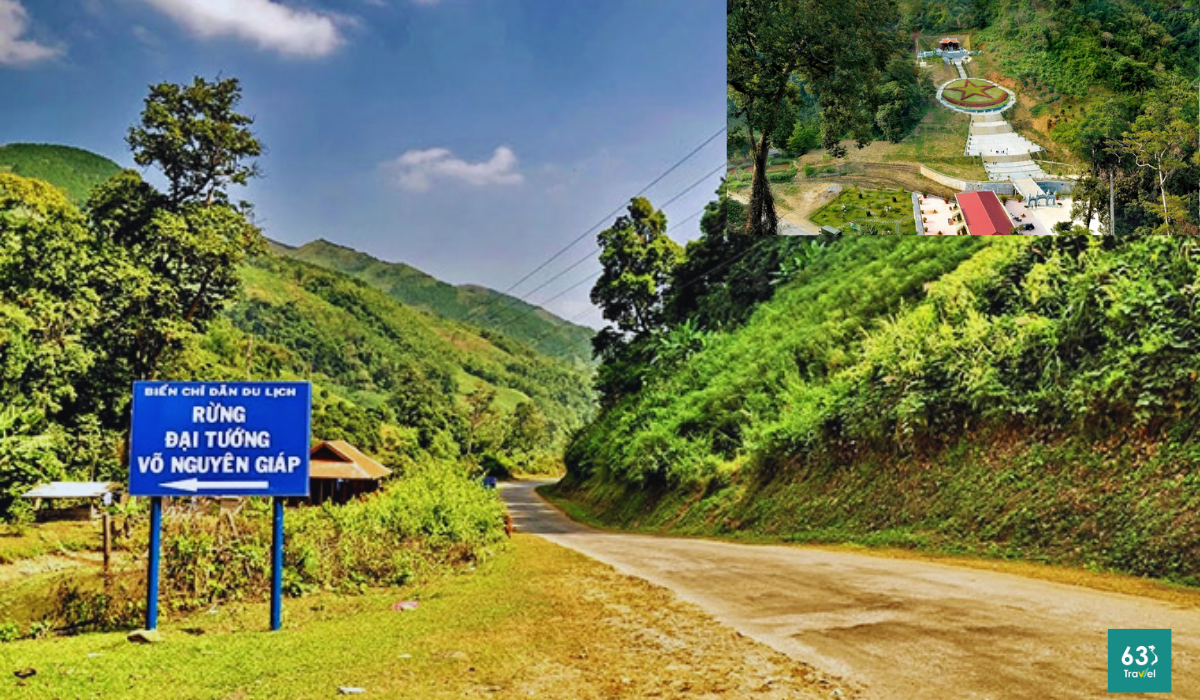
Son La keeps the green forest named after General Vo Nguyen Giap
The forest was the first military base of General Vo Nguyen Giap and our army. Important locations such as the observatory on Hien stream hill, the military field medical station on Bua stream and the command post on Tac Te stream on Tang Tu hillside still exist, marking memories of heroic battles. hero.
Visiting Ong Giap forest, visitors will immerse themselves in the historical space, feel the majesty and appreciate the sacrifices of previous generations. The forest is not only a symbol of patriotism but also a precious natural heritage, arousing pride in the nation's revolutionary tradition.
Archaeological relic of the stone roof of Mon village
The Ban Mon Stone Roof Relic is the first archaeological relic discovered in Northwest Vietnam. In 1927, French archaeologist Madeleine Colani excavated and discovered many stone tools, jewelry, and snail shells here. After that, a number of researchers investigated further, and in 2006, the Stone Roof of Mon village was recognized as a provincial relic. In 2017, the Provincial Museum invested in renovating this relic.
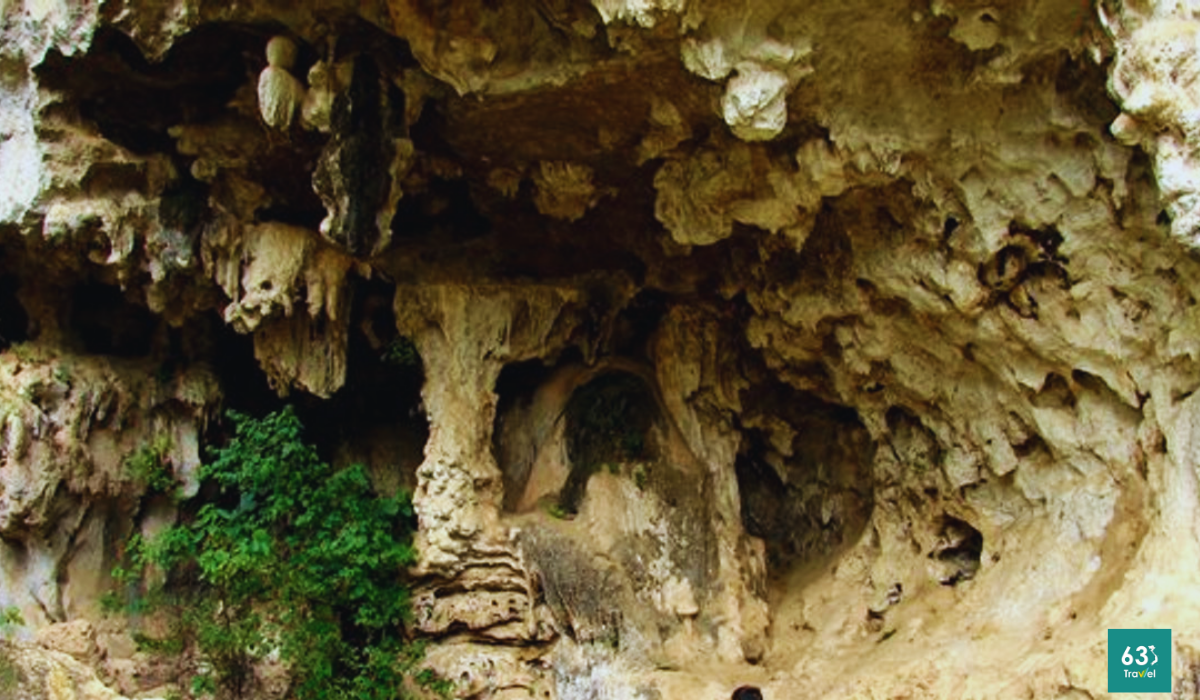
The archaeological site of the Mon village stone roof is ranked as a national monument
In April 2021, the Provincial Museum coordinated with the Institute of Archeology, the Vietnam Archaeological Association and the People's Committee of Thuan Chau district to organize an excavation and discover two prehistoric graves along with more than 1,000 stone artifacts and nearly 2,000 pieces of pottery. , many of which date from 10,000 to 5,000 years ago. This discovery proves that the Stone Roof of Mon village was once a residence, a stone ax workshop, and a burial place. With great value, this relic was ranked as a National Monument on March 20, 2023.
The stone roofs of Mon village contain many national historical, cultural and scientific values, related to the prehistoric community that once lived here. This is a valuable source of data for scientists to research and decode the values of relics, contributing to preserving and promoting the nation's cultural heritage. At the same time, promote local socio-economic development. The stone roofs of Mon village are also a unique geological and archaeological heritage, a valuable tourism resource of Son La during the period of opening, integration and regional connection.
Temple of Lady Han
When you come to Son La, don't miss the opportunity to visit a special temple from the 17th century. This temple is not only an example of patience and strong restoration, but also contains many stories Interesting and mysterious history.
After the main temple was flooded under the Son La hydropower plant, restoring this temple to its original form was an amazing feat. What is remarkable is that the temple still retains its beauty and attraction, being a sacred place that attracts tourists from all over.
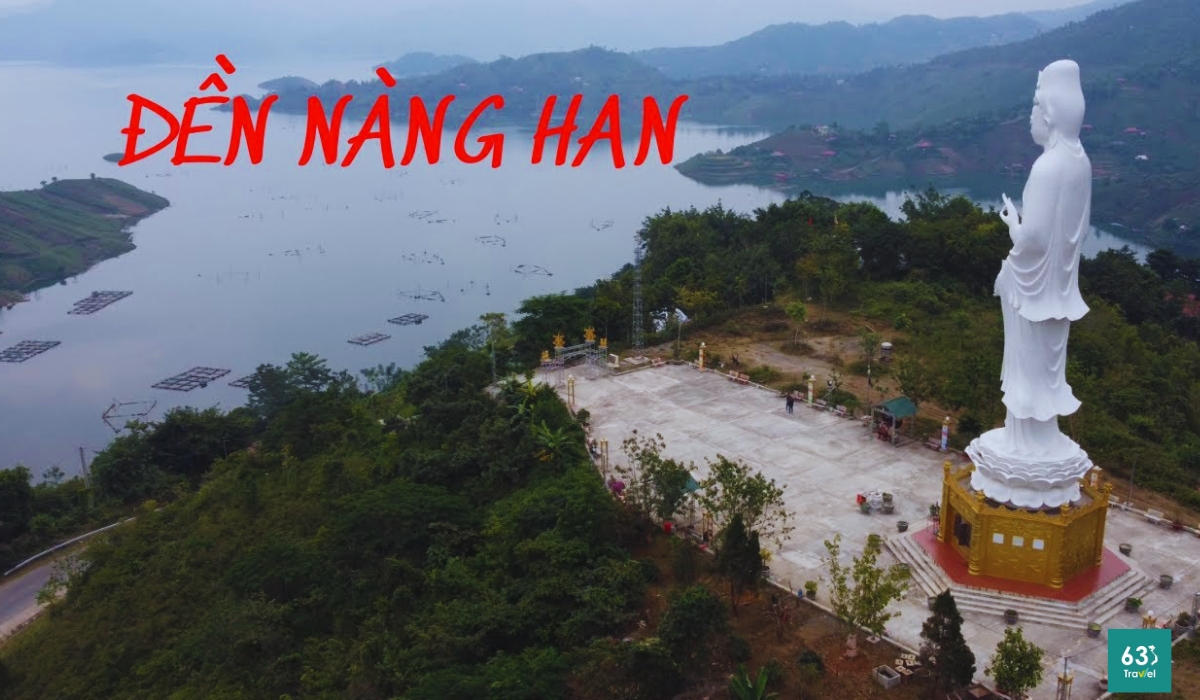
Temple of Han - Linh Son Thuy Tu in Son La
According to legend, this temple is related to the story of Han - the only daughter of the lord of the Kho Mu people in Chieng Phung (or Quynh Nhai today). The story of Miss Han carries the mark of love, intimacy and deep filial piety.
Visiting this 17th century temple, you will not only admire the ancient architectural beauty but also have the opportunity to learn more about the history, culture and special traditions of this locality. This is definitely an interesting and meaningful destination in the journey to explore Son La.
>> Read more: TOP provinces and cities that attract the most tourists in Vietnam
Archaeological site of Tang Me tomb cave
If you have the opportunity to come to Son La, do not miss visiting Tang Me Tomb Cave, one of the unique and rare relics, recognized as a National Monument since 2014. Located in Loi village, commune Suoi Bang, Van Ho district, this tomb cave is an ideal destination for those who are passionate about adventure and want to explore.
To get to Tang Me tomb cave, you will have to spend about 30 minutes walking from the center of Suoi Bang commune, crossing the trail and climbing over steep cliffs. However, this risk will be rewarded when you arrive at the tomb cave located halfway up the mountain.
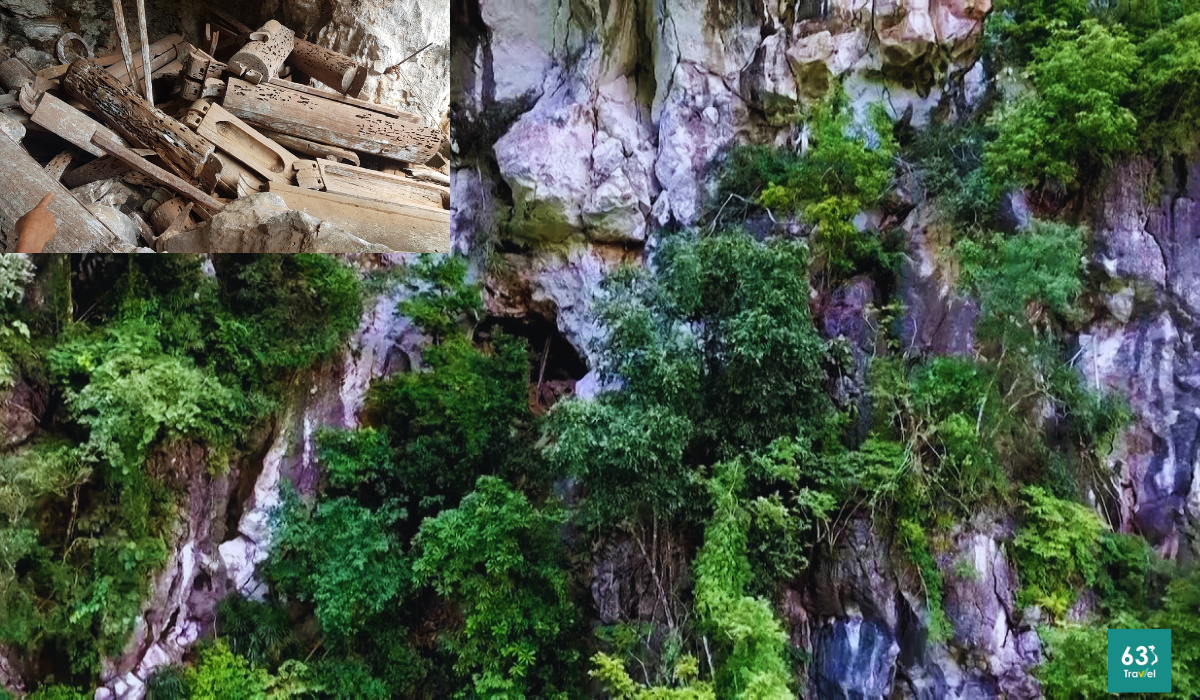
The mysterious world of ancient burial tombs hanging in the cave at the archaeological site of Tang Me tomb cave
Tang Me Tomb Cave has unique and strange characteristics. The most prominent feature is the coffins made from split wood, shaped like boats and decorated with sophisticated "swallow tail" images. The artifacts inside the coffins provide valuable information about the lives of ancient residents thousands of years ago.
This relic is not only a testament to the long-term residence of ancient people in Van Ho district, but also a valuable resource for scientists researching the history, culture and society of the land. This. At the same time, preserving and promoting the value of Tang Me tomb cave also contributes to promoting local economic and tourism development.
A Phu Cave
A Phu Cave (also known as Tham Cop Cave) is a unique and rare destination, located in Hong Ngai village, Hong Ngai commune, Bac Yen town, Son La province. This cave is described as the mouth of a frog biting its prey, with a majestic mountain face and many narrow niches. A Phu Cave is not only a place where visitors can explore the wild natural beauty but also a place to mark the local history and culture. Located in a primeval forest, with an airy and cool climate, this cave attracts many people who want to explore and experience.

A Phu Cave is a landmark with historical and cultural value
A Phu Cave consists of two doors on the East and West sides, connected to each other and divided into three compartments. The third chamber is the largest, with a high ceiling and a rough cave floor. The coffins are made from split wood and exquisitely decorated, showing the artistry of the ancients. In addition to the natural beauty and profound history, the local government has also taken measures to protect and preserve A Phu cave. The landscape around the cave is still preserved, without encroachment or environmental destruction. This is not only a tourist attraction but also a unique cultural heritage of this land.
Co Noi Junction historical site
When you arrive in Moc Chau, don't forget to visit the historical relic Nga Ba Co Noi - a place marking the important history of the Dien Bien Phu battlefield. This is not only the place of fierce battles but also the place that witnessed the unjust sacrifices of hundreds of soldiers. Majestic history has recorded unforgettable memories of the nation's children. You should stop here to remember and pay tribute to the heroes who sacrificed for their country.
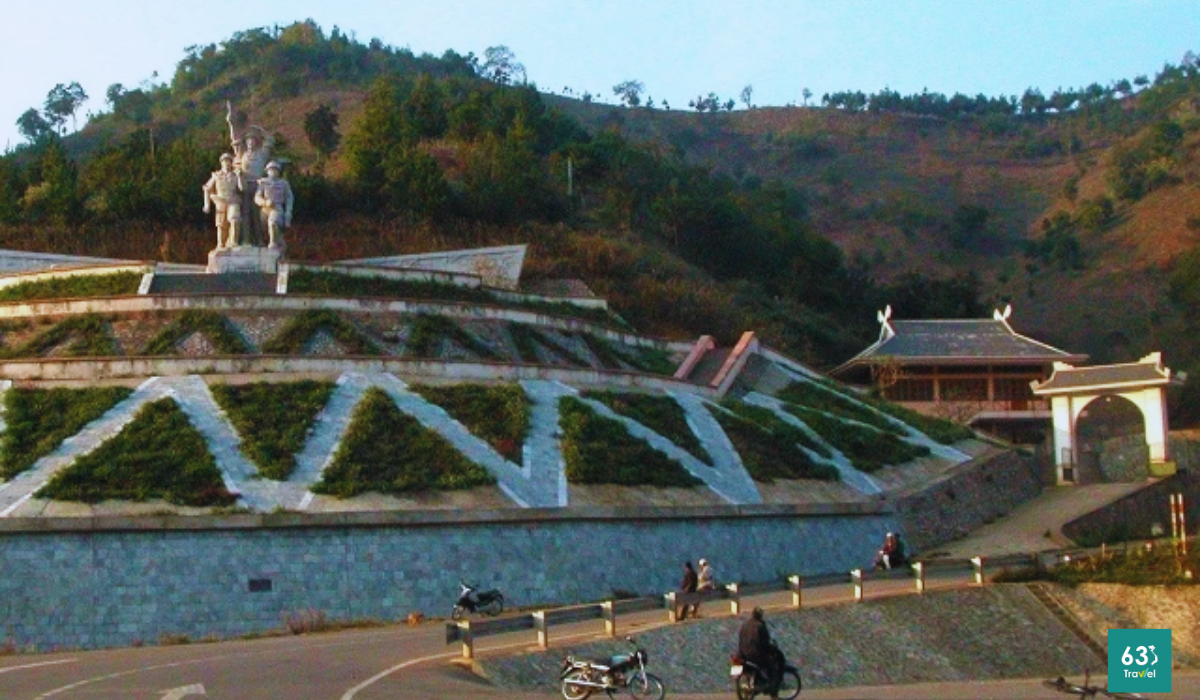
Co Noi intersection resounds forever with an immortal epic song
Ancient rock beach of uncle cave
Hang Chu village, located in Hang Chu commune, Bac Yen, Son La, is an attractive destination in the Northwest region inhabited by the Mong ethnic group. To get to the village, visitors have to cross forest roads, cross streams and difficult mountain slopes. Here, people discovered the ancient Khe Ho stone field, with unique and strange carvings.
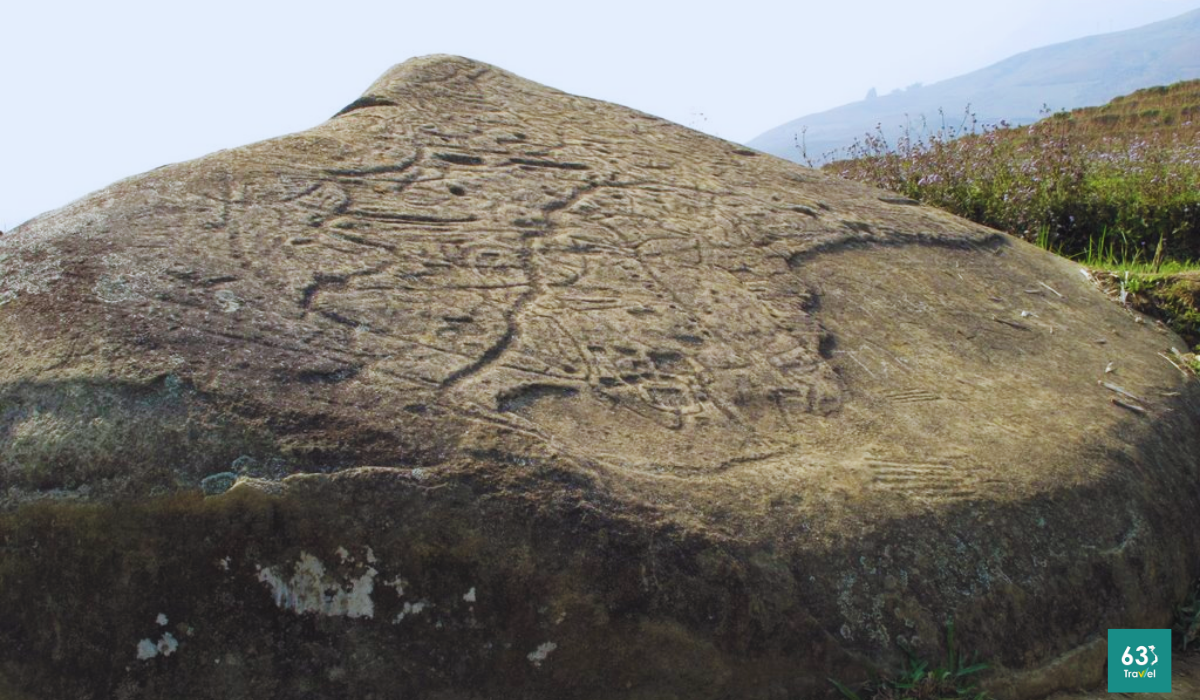
Discover the heritage of Khe Ho carved stone field in Son La
Located in Hang De village, not far away, four stone blocks have been engraved, located 5 to 16 meters apart. The intricate, spiral and strange patterns have attracted the attention of researchers and lovers of historical discovery. Khe Ho is located deep in a narrow valley, a must-see destination for those interested in archeology and culture. Discovered in 2011, this relic is currently a hot research topic with the desire to discover more historical and cultural mysteries of the Vietnamese people.
Hate Stele Km 64 relic site
When experiencing Moc Chau and visiting the Km 64 Hate Stele relic site in Thao Nguyen Moc Chau town, visitors will be immersed in an emotional historical scene. This is a commemorative place for the brave people of the North during the resistance war against the US to save the country. Located next to National Highway 6, 135 km from Son La town, this relic is located in the middle of the intersection of Son La - Hanoi and Phu Yen, with the main side of the stele facing National Highway 6, convenient for tourists. sightseeing.

Monument of hatred - engraved with the American enemy
To recognize the indomitableness of the people and to arouse national pride, in 1969, the government and people of Thao Nguyen Moc Chau town erected the Hate Stele at Km 64, with a clear message: "Eternally engraved in my heart the implacable hatred of the American invaders."
This is not only a historical symbol but also a warning and reminder of the nation's solidarity and determination in protecting the country's independence and freedom. Hate Stele Km 64 is not just a relic, but an inseparable part of the rural soul and resilient spirit of the people of Northern Vietnam.
Historical relic of Na San stronghold group
The Na San stronghold group in Son La is not only one of the main military bases of the French colonialists in the Northwest but also a symbol of the perseverance and courage of our army and people in the war for independence. create. Right from the early years of returning to occupy Son La - Northwest, the French colonialists chose Na San to build a solid military base system. With the strategic location and convenience of the mountains, they built a closed facility spanning over 10 square kilometers, called the Na San stronghold group.
This group is built according to the model of a closed arc, with 17 continuous bases. These bases are reasonably distributed in the area, including transport airports, food and weapons storage systems, and closely protected tunnels and trenches.
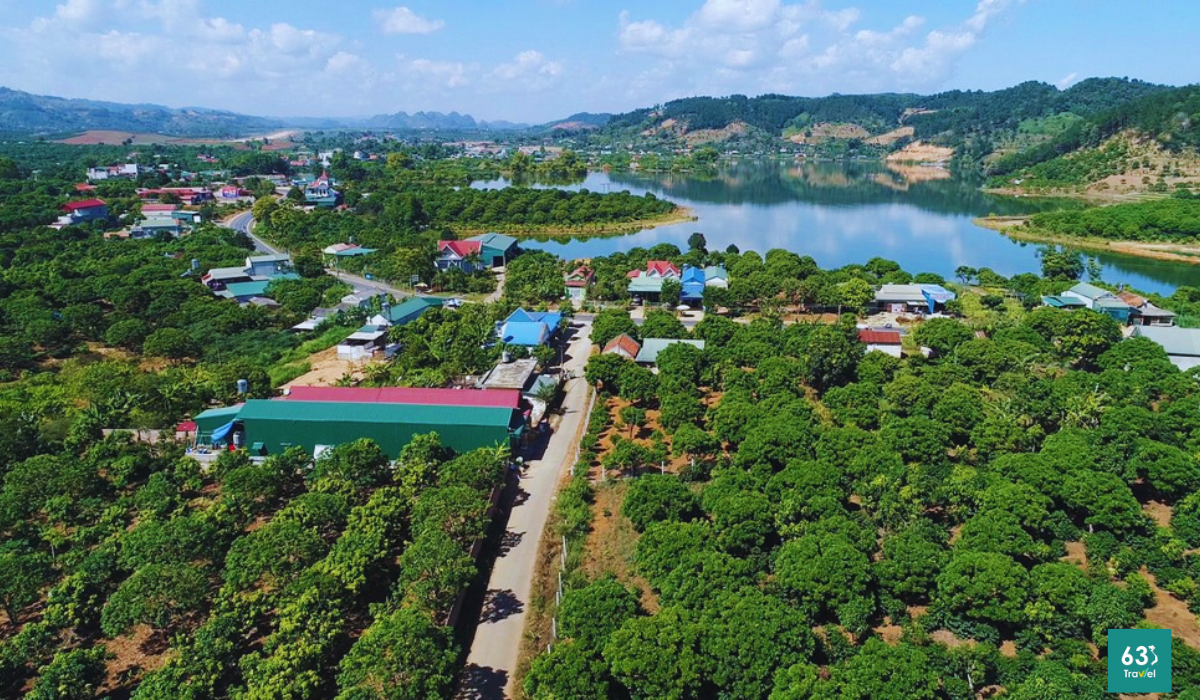
Na San stronghold group in the Northwest campaign after 70 years
The fierce battle at Na San during the Northwest campaign in 1952 contributed significantly to the final victory of the war. Our army and people destroyed many enemy forces, captured many weapons and ammunition, forcing the enemy to retreat and be completely isolated.
After the campaign, the Na San stronghold group was not only a symbol of victory but also a clear testament to the disastrous defeat of the French colonialists. Marking the end of a dark period, Na San was ranked as a National Historical Site in 1998, honoring the efforts and sacrifices of the nation in the war for independence.
>> Good article: TOP museums that attract international tourists in Vietnam
Thuan Chau Flag Tower historical site
The Thuan Chau flag tower historical relic, located in Pan village, Chieng Ly commune, Thuan Chau district, proves a special event on May 7, 1959, when President Ho Chi Minh and the Party and Government leadership visited Northwest region. On that day, on the occasion of the 5th anniversary of the historic victory of Dien Bien Phu and the 4th anniversary of the establishment of the Thai - Meo Autonomous Region, Ho Chi Minh and the Government delegation visited Son La province. In Thuan Chau, more than 10 thousand people and compatriots from 30 ethnic groups participated in a rally to celebrate the event.
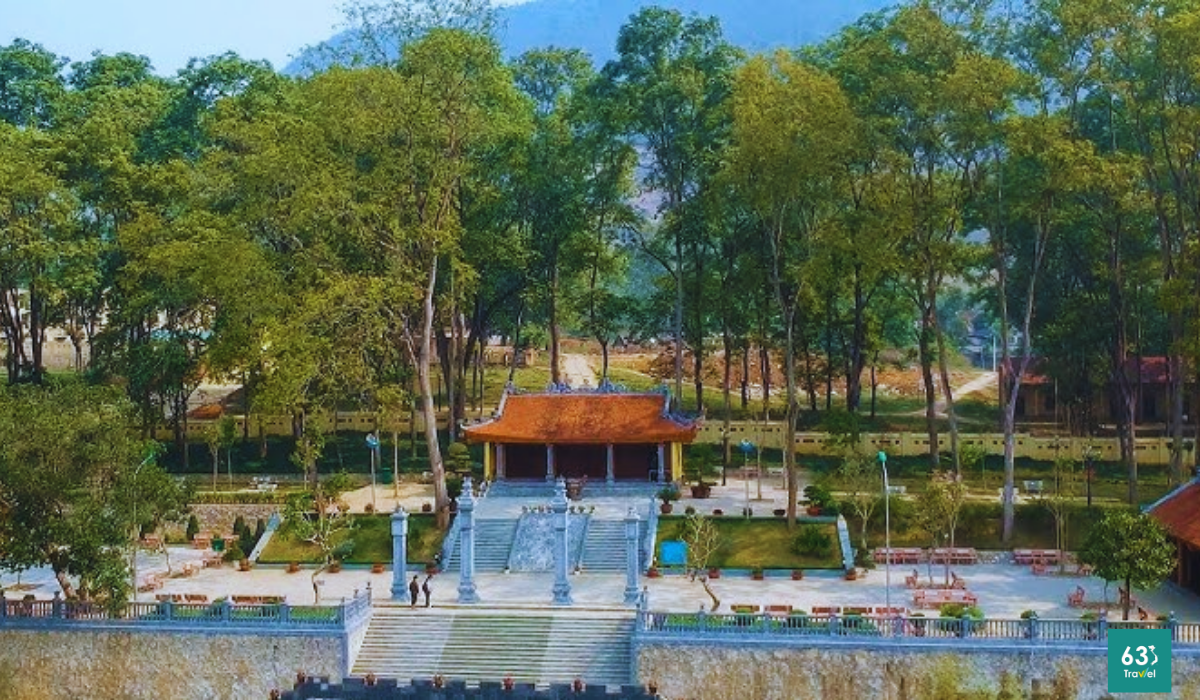
Thuan Chau Flag Tower Historical Site - Where Uncle Ho visited the Northwest
In the close atmosphere of a great family of nations, President Ho talked and interacted with everyone. Representatives of the Party and Government honored the achievements of the Thai-Meo autonomous region, awarding the First Class Labor Medal to the army, people, government and party of this region for their contributions in the resistance war against the French. and contributions in peace building. The Thuan Chau flag tower, certifying this meaningful historical event, was recognized as a National Historical Site on April 20, 1995.
Son La Provincial Museum
When you enter Son La Province, Son La museum is definitely a destination not to be missed. This is not just a regular tourist destination but also a shining historical relic, located within the grounds of Son La Museum and Prison.
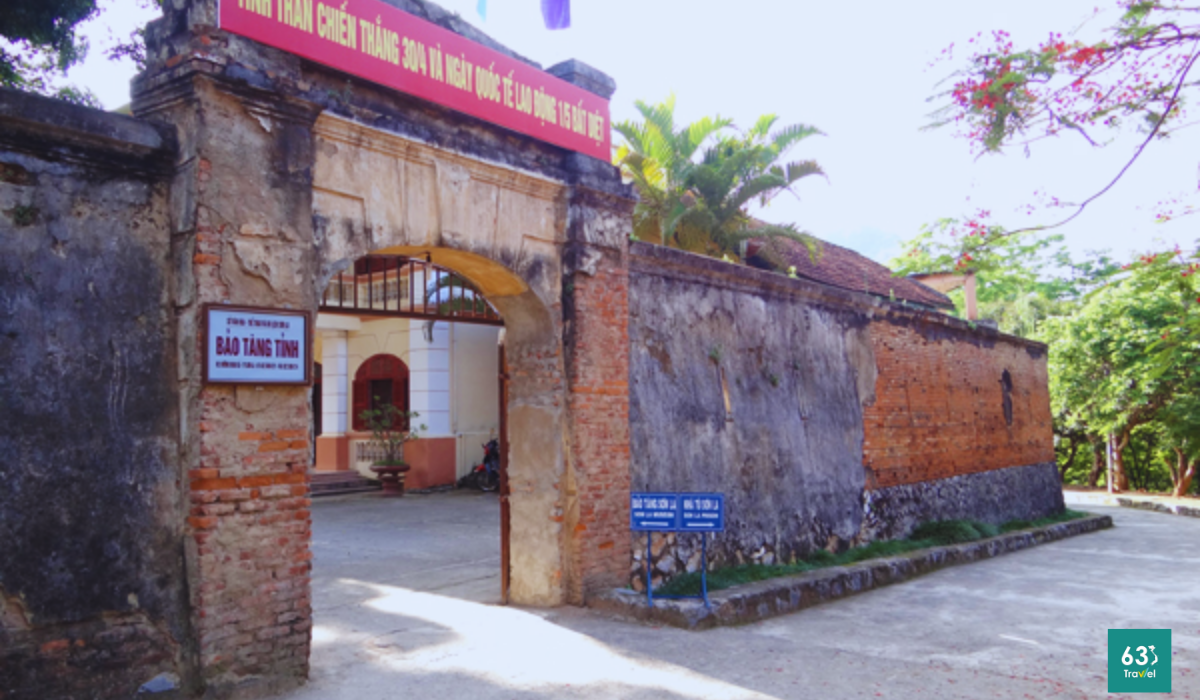
Son La Museum - A proud place to preserve historical evidence
Son La Museum is not only a place to display ancient relics from prehistoric and early historical times, but also a place to preserve and deeply reflect the unique culture of 12 ethnic groups living in Son La. You can admire thousands of unique artifacts, from everyday tools to traditional costumes, from paintings to sculptures.
In particular, the museum also owns an impressive collection of ancient Thai and ancient Dao books, with nearly 1,000 books of many different genres such as epics, epics and folk poems. This is a great opportunity to explore the rich culture and history of this land.
The Guilin Stele dominates
When you arrive in Son La province, you cannot miss a meaningful historical and cultural relic, the Que Lam Ngu Che stele. This place preserves the autographs of a great figure - King Le Thai Tong. During the journey to conquer the Northwest region, when stopping at La Cave, also known as Tham Ke, the king was fascinated by the peaceful beauty of the landscape here. That was when he wrote the poem "Guilin Ngu Che", a literary work that shines on the vertical cliff of the cave entrance.
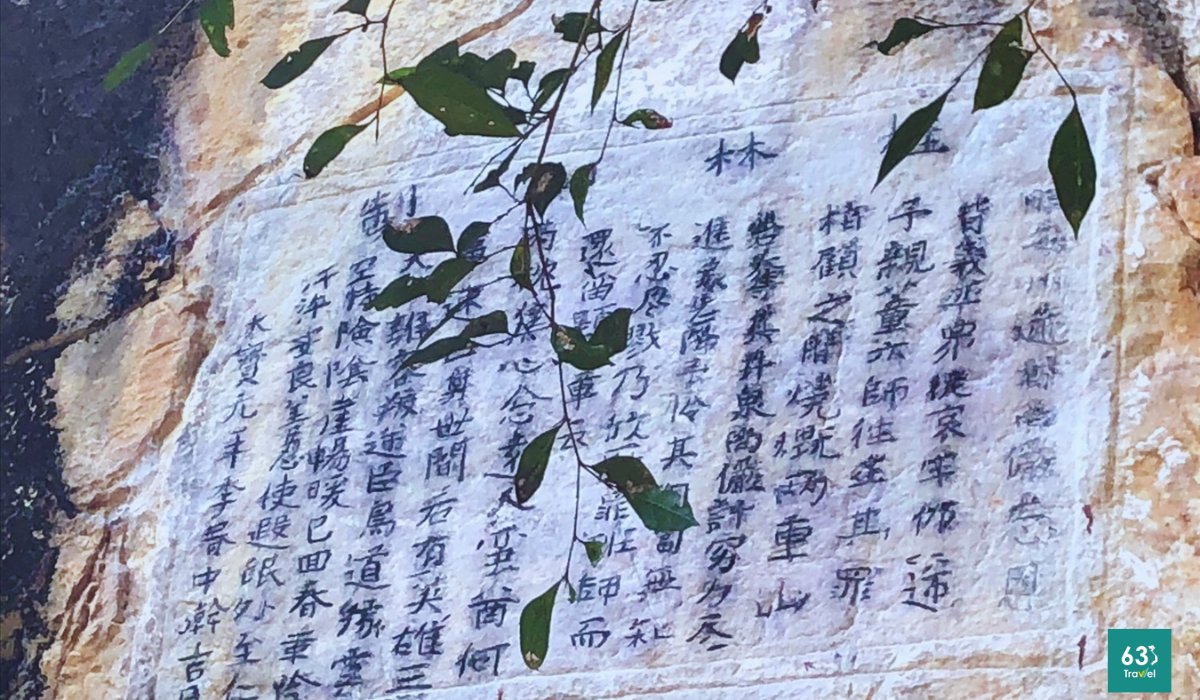
Que Lam Ngu Che stele relic - Autograph of King Le Thai Tong
This is not only a secret of history, but also an attractive tourist destination when you explore this land. The epitaph "Guilin Ngu Che" is an inseparable part of Son La's special historical and cultural story, waiting to be discovered and experienced.
Ban Heo banyan tree
In the historical footsteps of Son La hometown, the ancient banyan tree in Heo village became a symbol affirming the strong revolutionary spirit. Through countless events, from difficult days, this place has witnessed the strong solidarity of the party committee, government and people of Ban Heo. Along with that, the descendants of Mr. Ca Thi Khien - who worked as a liaison for revolutionary cadres at Son La prison - still preserve and develop the spirit of their homeland.
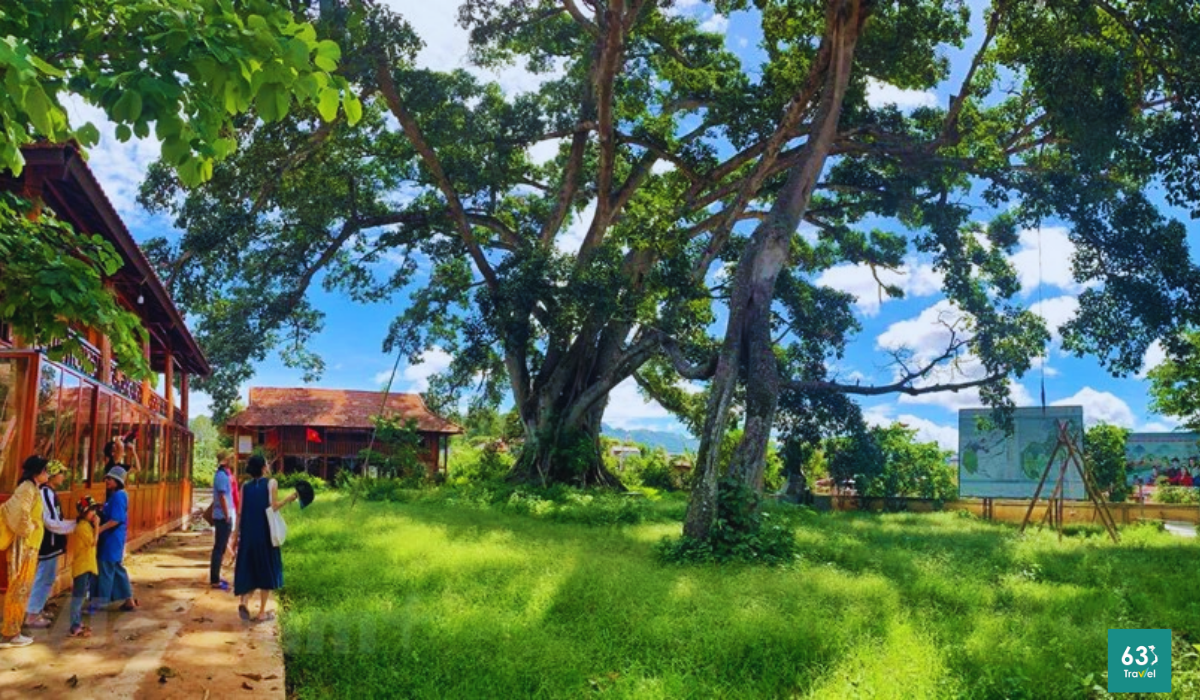
In Son La, there is a giant 500-600 year old banyan tree with two strange trunks.
Located in group 2, To Hieu ward, Son La city, the Heo banyan tree has become a secret connection point between Son La prison and outside revolutionary forces. Here, Ms. Ca Thi Khien worked hard to help and protect the contact point, contributing to the success of the struggle for national independence. Today, this banyan tree is not only a historical relic, but also a destination for tourists when visiting the museum and Son La prison.
Son La Prison Relics
Resting on the historical side of Son La hometown, Son La prison is a destination not to be missed for those who love exploring history. This used to be the place where 14 political prison groups with more than 1,000 prisoners were detained. Although the material conditions were extremely harsh, this place nurtured many outstanding soldiers, contributing to the victory of the August Revolution in 1945.
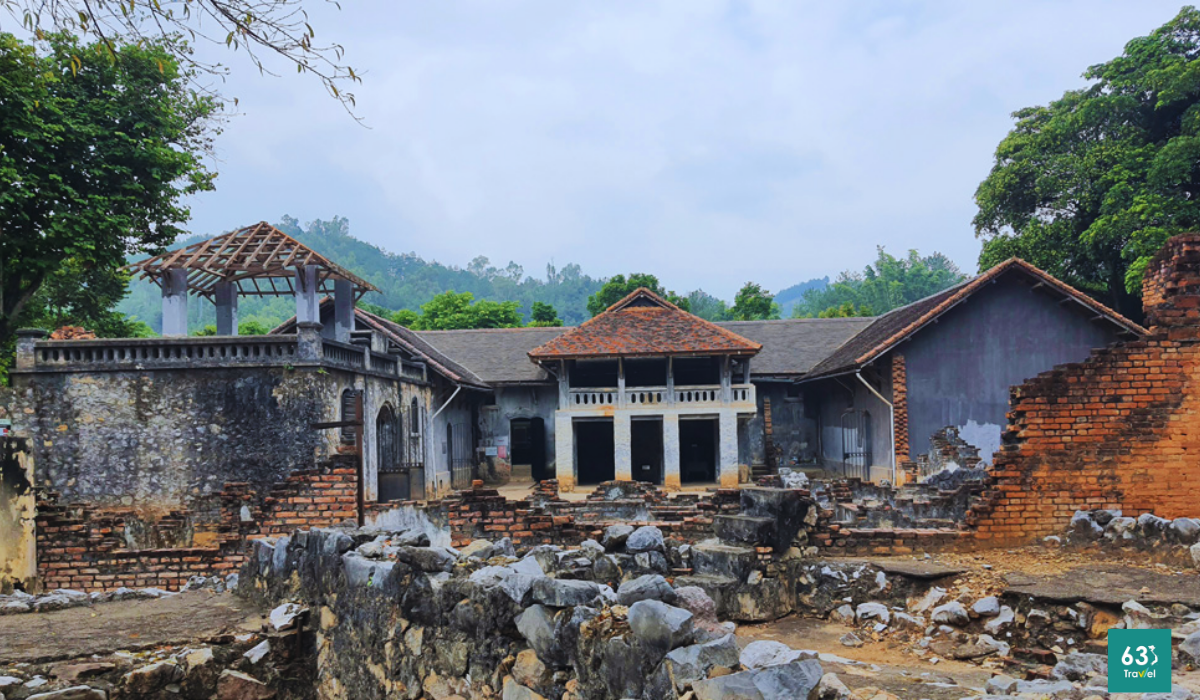
Son La Prison - "red address" for educating revolutionary traditions
Son La Prison is living proof of the brutality of the French colonial regime against the Vietnamese people. Built in 1908, the prison has witnessed thousands of Vietnamese people being imprisoned and tortured. With harsh regimes and torture methods, this place became a living hell. However, unexpectedly, the resilient soldiers turned this prison into a training school, a place to nurture the indomitable will to fight.
Son La Prison today has become a destination to better understand the tragic past of the Vietnamese people and forever remember the indomitable will of those who sacrificed for freedom and independence. This is an important material evidence, demonstrating the patriotic spirit and indomitable will of the Vietnamese people, attracting a large number of domestic and foreign tourists to visit, study and research.
Above are 16+ historical sites in Son La that you can come and experience. Please save this list for your exciting travel experience in Son La. Don't forget to follow 63 Stravel to update the latest Vietnam travel information!
Son La 4461 view
Update day : 28/05/2024
In addition to the name Dai Yem, this waterfall is also called "Nang waterfall" or "Ban Vat waterfall". The waterfall originates from two streams of Bo Co Lam and Bo Ta Chau, located at the confluence of Vat stream and Bo Sap stream, in Muong Sang commune, Moc Chau district. Legend has it that more than 700 years ago, there was a couple who loved each other dearly. But because of the war, both had to separate. The boy went to war, and the girl went to the waterfall every day to wait for her lover to return. One day, it rained and stormed, the water flooded the entire waterfall. The girl was swept away, leaving only the token of love, an embroidered scarf, scattered near the waterfall. The villagers mourned so they named the waterfall "Dai Yem", which in ancient Thai means "Love Thread". Because of this touching legend, the waterfall has become a place to "prove love" and an ideal destination for many couples. Currently, the waterfall is being preserved and managed by Dai Yem Waterfall Tourist Area. Like a girl in the age of love, Dai Yem waterfall is sometimes gentle and peaceful but also sometimes fierce and passionate. To fully feel the wild beauty mixed with a bit of dreaminess of the waterfall, you should come here during the pouring water season. The period from April to September is the best time to see the falls. At this time, the stream flows rapidly, the amount of water pouring in is huge, creating a white, mesmerizing curtain, making viewers overwhelmed and excited. But if you want to see something gentler and quieter, you can also visit the waterfall in the dry season. At that time, the waterfall will become gentle and full of dreams. The sound of the gurgling stream mixed with the chirping of birds from the deep forest, all blend together, creating a poetic scene. But if you want to see something gentler and quieter, you can also visit the waterfall in the dry season. At that time, the waterfall will become gentle and full of dreams. The sound of the gurgling stream mixed with the chirping of birds from the deep forest, all blend together, creating a poetic scene. The first experience that any tourist cannot miss is admiring the majestic beauty of Dai Yem waterfall. The waterfall is more than 100m high, divided into two distinct branches: the upper waterfall is about 4,000 m2 wide with 9 floors symbolizing 9 levels of love, while the lower waterfall is smaller (area of about 300 m2) and includes 3 floor. The two clusters of waterfalls are about 200m apart, flowing day and night. From a distance, they look like a soft peach band winding around the cliff. With its poetic and magical beauty, this waterfall has become a place to visit, picnic, check in and take photos for many tourists, especially young people.
Son La 1715 view
From January to December
Tien Phong Lake in Son La is a typical place of wild and majestic beauty, but extremely romantic in the Northwest mountains and forests. Visiting this land, visitors will admire the charming feng shui and enjoy the fresh air of nature, and have many interesting experiences when yachting on the lake. Located in the middle of the vast steppe, Tien Phong Lake has thousands of winds and warm sunshine, captivating many tourists. Tien Phong Lake in Son La is located in Muong Bom commune, Mai Son district. The place is located right next to National Highway 6, 23km from Son La town, 7km from Hat Lot town and 2km from Na San airport. This is a prime location surrounded by majestic mountains. It is a place surrounded by beautiful nature - in the middle of the immense steppe. To the East and North are two majestic mountain ranges, one after another. To the East is the Na San plateau full of fruits and thousands of green tea hills. All have created a charming landscape, attractive nature, bringing moments of relaxation and peace, holding the traveler's feet. The scenery of Tien Phong Lake is created from Tien Phong dam made of earth and solidified by solid concrete panels. Tien Phong Dam is 23m high, 120m2 wide and 120m long. Coming here, visitors can witness with their own eyes the beautiful natural scenery with a stretching blue color. The vast lake surface is jade green, in the distance there are deep green tropical forests and deep clouds and sky. Nature guides us, people do not want to leave the majestic landscape of Tien Phong. Cruising is an attractive experience for tourists when visiting Tien Phong Lake in Son La. There's nothing more wonderful than floating on the water and taking in the wonderful view of nature. You can choose to row a manual boat, a pedal boat or a motor boat depending on your preference. Many tourists also choose to fish to preserve the beautiful nature. Just do it the way you like, immerse yourself in nature to feel the slow passage of time, preserving the most wonderful emotions. From a distance, the floating island looks like a turtle's shell floating in the middle of the lake. The landscape here is always green and fresh from the young grass and the wind. The wind brings cool and refreshing steam to the small island. Exploring the floating island, visitors will be immersed in the fresh nature here, enjoying the freshest and most peaceful air of their lives.
Son La 1857 view
From January to December
Possessing an impressive height above sea level of 2,000 m, the mountain peak is located in the Vietnam - Laos border area and has received the love of many tourists in recent years. After arriving at the center of Moc Chau district, you need to travel another 40 km to reach the foot of the mountain. In addition to the name Pha Luong peak, visitors can also use the name Bo Lung to talk about this tourist destination. When you come here, you will experience the feeling of conquering the mountain peak with impressive heights. In particular, it is the feeling of seeing the majestic and wild scenery from above that is not available everywhere. For those who love to explore and are passionate about adventure sports, this will be a great destination. You can also enjoy the fresh, cool atmosphere of the Northern highlands and relax after the stress and fatigue of life here. For young people, this is an ideal check-in point and great "cloud hunting" in the early morning. Featuring the climate of the North with four distinctly changing seasons, visitors can reach Pha Luong peak at any time of the year. Because this place at each time will bring its own unique beauty and impression to tourists. However, because the road to the top of the mountain is up to 2000m high and difficult, visitors should choose a travel time from March to April. This is the time with warm sunshine and no rain, convenient for climbing. The mountain is safer as well as helps the sightseeing process. One of the famous check-in points when conquering Pha Luong peak is the uniquely shaped rock outcrop. The breadth of space and scenery, along with the rocky outcrop that juts out, make your photo even more impressive. Visitors do not need to worry because the stones are quite large and thick. Be careful when checking in in the rain because they are easily slippery. In addition to experiencing the scenery and atmosphere at the top of the mountain, visitors also have the opportunity to discover more about the typical Lao market. You can find handicraft products, specialty dishes in Moc Chau, dried meat,... as gifts for relatives or friends after the trip. Although it is an attractive tourist destination and brings wild and impressive beauty to tourists. But Pha Luong peak is quite difficult to conquer, so in addition to experience, you also need to know the following notes: With an altitude of 2000m, when you reach the top of the mountain you will see the temperature drop quickly. Especially, if you come in the winter, the temperature is lower, so you need to bring warm clothes, towels, wool hats, gloves, etc. To avoid sudden changes in temperature that affect your body. During climbing, you should use specialized shoes for climbing. Do not wear flat shoes or sandals because they can cause slipping and danger during movement. Visitors should carefully consider their health and mobility before deciding to climb Mount Pha Luong. People with cardiovascular diseases should not move to the mountains. Before conquering the mountain peak, you should have a light snack and drink water to give yourself more energy. Absolutely do not arbitrarily throw trash indiscriminately while moving or visiting the mountain top. Always bring identification documents to present for check-in procedures at the border station.
Son La 2001 view
From March to April
In the heart of the city, there is a hill named Khau Ca lying beside the Nam La stream. This place also preserves historical evidence of Son La Prison - evidence of a historical period of revolutionary struggle and the spirit of injustice. The remains of resilient communists who were imprisoned by the French colonialists, and the Son La museum, which displays many precious artifacts, introducing the historical and cultural traditions of a community of 12 ethnic groups united together. together to build Son La into a rich province of Vietnam. Son La Prison was built by the French colonialists in 1908 with an initial area of 500 m2. The prison is built quite solidly: the walls are built of stone and brick, the roof is covered with corrugated iron, there is no ceiling, the beds for prisoners are also built of stone, the surface is cemented, the outside edge is attached with a system of vertical leg shackles. along the length of the floor. In each cell there is a floating toilet built higher than the floor, without a lid, without flushing water, and not cleaned regularly. With such a design, in the summer, the Lao wind of the Northwest region causes scorching heat, the frost creates cold, bone-chilling cold in the winter, combined with the polluted environment in the area. Each cell has caused diseases to arise and spread very quickly among prisoners. In 1930, the Communist Party of Vietnam was born and led the people to fight against the brutal regime of feudal colonialism. The struggle movement surprised the enemy, who frantically sought every way to suppress and arrest patriotic Vietnamese people in an attempt to quell the revolutionary movement. On the other hand, strengthen the construction and expansion of the prison system throughout the country, paying special attention to Son La prison. In 1940, Son La Prison was expanded to add a large prison to hold more prisoners and send a number of female prisoners to Son La, but that plot failed to materialize. Thus, through 3 times of construction and expansion, Son La prison has a total area of: 2,170m2. The French colonialists turned this place into a living hell to imprison, deport and destroy the will of the Communists to fight. With an extremely harsh prison regime and extremely cruel torture methods, the enemy thought they could destroy the spirit and body of the revolutionary soldiers, but this place became a revolutionary school. network, train the will and supplement the Party and the revolution with loyal communist soldiers and party members, most notably the role of comrade To Hieu and many other loyal comrades. After being devastated twice by the enemy's bombs, the old relics are now dilapidated, remaining almost nothing more than a pile of destroyed bricks, and the ruined prison walls are a testament to the brutal crimes of the enemy. What remains intact is the To Hieu peach tree, a symbol associated with the name of the steadfast Party Secretary of the prison, which still blooms brilliantly when spring comes... In 1952, when the French colonialists withdrew from Son La, they bombed to erase traces of their crimes. The second time in 1965, the American imperialists raided Son La Town and destroyed part of the prison. In 1980, Son La Museum carried out the first restoration: Leveling bomb craters, rebuilding some surrounding fence sections; The second time, in 1994, restored the two watchtowers, the kitchen, the large prison, reinforced the underground bunker, and built the walls of the cells according to the traces of the old foundations. In 1994, Son La Museum intended to restore the entire relic site to its original form, but could not find complete records, so there was not enough scientific basis to restore the entire site. Just build the walls a little higher so visitors can visualize the structure of the Son La prison complex. Every year, the historical site of Son La prison welcomes hundreds of thousands of tourists to visit, research, study... Surely, at some point, tourists come to Son La, return to the mountains and forests. Northwest to experience and reminisce about the war that took place more than a century ago; With the skillful leadership of the party, the passionate patriotic spirit willing to sacrifice for national independence, the strong solidarity between peoples... We have left behind a peaceful country for today's posterity.
Son La 1807 view
From January to December
With an area of 6,915 square meters, Bat Cave contains an underground water source that never dries up. The name Bat Cave originates from the fact that in the past, there were large colonies of bats living and nesting here, but now they have left elsewhere. However, the name Bat Cave is still called by people here to this day as a familiar name from a long time ago. Above the ceiling of the cave are high stone arches hanging down to form magical shimmering stalactites. These stalactites form many interesting shapes such as fairies, fairies, animals... All create a scene that is both sparkling and majestic. This is a place that when traveling to Moc Chau you should not miss! Legend has it that once upon a time, there was a sacred dragon who, when flying over this land, saw the majestic mountains and cool climate, so he humbled himself and hid in Bat Cave and resided here. That's why this mountain range has many mysterious colors such as: white in the morning, blue at noon, then pink in the afternoon, and finally purple at sunset. People here often tell each other that it is because the dragon's body is surrounding the mountain. Later, when the dragon died, it released 7 pearls to repay the favor. The 7 pearls are the 7 mountains that later created Bat Cave. Thanks to the legendary stories that have been passed down from generation to generation, this place becomes even more attractive and makes many curious tourists want to come here to verify. From the moment you enter from the cave entrance, the light shining into the cave will make you feel like you are lost in a fairyland with different dark and light shades. Visitors will admire the beauty of the limestone stalactites hanging down, creating an amazing natural picture. Furthermore, these rocks also have many different shapes, making them interesting for visitors. The most special is the stone block shaped like a man and woman in love in the shallow lake in the middle of the cave, a highlight that makes everyone admire. In the cave, in addition to the shapes created from limestone blocks, there are also many banyan trees whose roots form shapes on the ground such as elephants, tigers... Another special thing about Son Moc Huong Cave is that the middle of the cave is arched higher than other places in the cave, with a stone curtain at the entrance. This is called the "princess" chamber, which is also an attraction in this place. This. Bat Cave is both a place to visit and a place to explore with forests and trees growing around, so visitors need to pay attention to the following things: Because the cave is located in a dense forest, visitors should wear comfortable and covered clothes to both climb the mountain and avoid being bitten by insects or mosquitoes. You should also bring mosquito spray to ensure safety. , especially with children. When visiting Son Moc Huong Cave, parents need to pay attention to their children's health when climbing the mountain and visiting the cave, then provide timely solutions if the child is too tired or too hyperactive to run around. toss.
Son La 2698 view
From January to December
Moc Chau has four seasons: spring, summer, autumn, winter with mild weather and flowers and fruits all year round. In January, the plateau is green with budding tea hills, peach blossoms, plum blossoms, apricot blossoms, cherry blossoms... From mid-May, plums begin to ripen, people harvest plums and sell them to lowland traders. There are no flowers in summer, nor is it strawberry season, but this place is very suitable for picnics because of the fresh air and many outdoor activities. The persimmon season in Moc Chau starts from August to December every year. In particular, the crispy persimmon season usually comes earlier, from August to October, while from October to the end of the year is the season for astringent persimmons. The white mustard season in Moc Chau begins in November. In December, bright yellow wild sunflowers decorate the plateau. Moc Chau is nearly 200 km from Hanoi. If traveling by motorbike, you should follow the old Highway 6 because there are many beautiful scenery along the way, but you should pay attention to the steering wheel because the road is quite degraded. The journey takes about 4-5 hours. On the way, you will pass the S-shaped road in Van Ho district. Most travelers stop to admire the scenery and check-in at this soft S-shaped curve. If you take a bus, you can choose routes to Son La from My Dinh or Yen Nghia bus station, then get off at Moc Chau with a high-quality bus ticket price of about 200,000 VND. If you drive your own car, you don't need to worry too much because the road is big and easy to go despite many steep passes. Be careful, drive at the right speed and pay attention to the lane when passing. In the summer, the roads are less foggy but visibility is limited when it rains. The section that may be cloudy is the road from Thung Khe section. Moc Chau has many motels. However, to get quality accommodation during peak season, you should still call to book in advance. There are eco-lodges (with mountains, lakes, stilt houses) or homestay-style community motels. The price of a room is about 200,000 - 300,000 VND per night but there are also many motels with lower prices. Some suggested "chill" homestays are MAMA's House, Le Chalet du Lac, Fairy House Moc Chau, House By Lake, The Nordic Village, Moc Chau Retreat... Room prices range from 300,000 to 1,000,000 VND per night. To fully explore Moc Chau, you can go quickly in 2 days. If you have more time, about 3-4 days is best, you will have plenty of time to find beautiful camera angles to take photos or go to neighboring famous tourist areas such as Thung Nai, Mai Chau, Hoabinh water electric... Places you can visit: Ban Ang pine forest, Mu Nau plum valley, Sunflower garden, Moc Chau tea exchange, Chieng Khoa waterfall, Nang Tien waterfall, Dai Yem waterfall, Grassland 68, Nguyen Thuy village, Pha Luong peak. Eateries and restaurants are located along the town center passing through Highway 6. In addition to specialties such as plums, tea or milk, Moc Chau is also famous as a delicious place to eat. The dishes not to be missed when coming here are fried veal, fried stream fish, multi-dish lentil fish, salmon hot pot, pork blood pudding, buffalo meat on the stove, vegetables dipped in fish intestine sauce or five-color rice. If you want to eat dairy veal, you can find restaurants Dong Hai, Xuan Bac 181, Nam Hung 70, or Lan Hong 64, Ve Quan Moc Chau... A strange dish to try is Moc Chau fresh milk hot pot. The broth is simmered from bones and vegetables, a moderate amount of milk is added to give it a milky white color and mild flavor, and corn is added for sweetness. When the hot pot begins to boil, the layer of milk on top begins to thicken, giving it a fatty and fragrant taste. This is also the time when the hot pot broth is at its most delicious. In the past two years, Moc Chau has also been famous for producing strawberries with quality not inferior to those of Japan or Korea because they are grown using Japanese technology. Winter will be the strawberry harvest season on farms with gardens filled with ripe red strawberries, sweet and sour taste, and if eaten with Moc Chau yogurt, it is very easy to become "addictive". In the summer, after plum season, there will be melon season with sweet fragrant fruits. You can buy tea, milk, cat apples, corn, corn wine... as gifts from these locations: intersection 73 near town, sub-area 32 and Bo Bun, intersection 70, peach garden intersection, sub-area Chieng Bi area. Moc Chau usually has warm sunshine during the day, but the night temperature is quite low and foggy. You need to bring enough warm clothes to ensure your health, and check your vehicle's lights before departing. Do not litter, step on people's mustard beds or climb on trees, break wild peach branches, plum branches, flowers...
Son La 2045 view
January to December
Thuan Chau Flag Tower historical site is located in Pan village, Chieng Ly commune, Thuan Chau district. This place marks a historic event on May 7, 1959, when President Ho Chi Minh together with the Party and Government leadership visited the Northwest. During the resistance war against the French and after peace was restored in the North, despite being busy with thousands of national affairs, Uncle Ho, the beloved Father of the nation, always cared about the people of the Northwest ethnic groups. Responding to Uncle Ho's trust, the people of the Northwest ethnic groups were courageous in fighting, enthusiastically emulating productive labor and wished to welcome Uncle Ho to visit and report to him on his achievements. On May 7, 1959, the wishes of the people of the Northwest peoples came true. The square of the capital of the Thai autonomous region, Meo, was resplendent with flags, flowers, banners and slogans and more than 10,000 people representing 430,000 people from the Northwest ethnic groups happily welcomed Uncle Ho leading the Party and Government delegation. cover the visit. With an extremely simple, intimate and close gesture, Uncle Ho recognized and praised the sacrifices and enormous contributions of the people of the Northwest ethnic groups in the resistance war against the French colonialists and in restoring the economy. economy after the war. On behalf of the Government, he presented the people of the Northwest ethnic groups with the first-class Labor Medal. He advised: We must enthusiastically compete for economic and social development, strengthen economic sectors, apply science and technology to production, develop education and healthcare networks, and strengthen national security. room. More than 40 years have passed, and his advice has been persistently strived to be implemented by the Party Committee, government and people of Son La ethnic groups, and has been making great changes in the Western region of the country. big. Today, the Thuan Chau flag tower historical relic is located right on the campus of Thuan Chau district stadium. Source: Son La province electronic information portal
Son La 2418 view
Que Lam Ngu Che stele historical relic belongs to group 3, Chieng Le ward, Son La city. This place demonstrates the historical period of the talented and great strategist Le Thai Tong and his soldiers conquering rebels in the western border region of the country, keeping peace for the country. The relic was ranked at the National level by the Ministry of Culture and Information on February 5, 1994. King Le Thai Tong, whose name is Nguyen Long, is the second son of King Le Thai To (Le Loi) and Queen Mother Pham Thi Ngoc Tran, a native of Quan Lai, Loi Duong district (now Tho Xuan - Thanh Hoa). ). Since ascending the throne, King Le Thai Tong has paid great attention to the Northwest region, the land of the country. To consolidate and ensure national unity, like King Le Thai To and other kings, during the 9 years of reigning the country, King Le Thai Tong twice commanded soldiers to go to the Northwest to suppress traitors. inverse. In March of the year Canh Than (1440), the king for the first time personally and with his soldiers went to the Western town to fight a rebel army named Thuong Nghiem in Chau Muong Muoi (now Thuan Chau district, Son La province). Wherever the king went, he was supported by the people, so the royal army quickly crushed the rebels. On the way back, the king and his soldiers stopped at Dong La (Tham Bao Ke), a natural rock cave in Muong La province. The king saw that this place had beautiful scenery, favorable geography, profound meaning and a peaceful soul. The king had his soldiers carve a poem and preface on the cliff at the entrance of Dong La. The poem, Guilin Ngu Che, has the following meaning: "The chief of Thuan Chau, Thuong Nghiem, rebelled, was ungrateful, and led his troops to follow the Ai Lao people to rebel. Personally commanded six armies to conquer it. Thuong Nghiem used all his strength and offered an elephant to surrender. I felt sorry for him for kneeling and crawling without a weapon, not having the heart to cut him, so I forgave him, then brought the army back and left a poem. Exactly one year later, in March 1441, the king again sent troops to suppress the Nghiem Nghiem rebellion in Chau Muong Muoi. Everywhere he went, the people responded and helped him, so the royal army quickly captured General Ai Lao. Dao Mong, at the same time captured Thuong Nghiem's children Sinh Tuong and Dong Dong. The traitor Thuong Nghiem surrendered and accepted the crime, from now on the western border of the Fatherland has been at peace. To pay tribute to the merits of King Le Thai Tong and to make the Que Lam Ngu Che stele monument forever dignified and shine in the hearts of successive generations, meeting the spiritual and healthy religious needs of a large number of people. people, with the consent of the Ministry of Culture and Information, in September 2001 the Provincial Party Committee and People's Committee of Son La started construction of the temple of King Le Thai Tong in Son La town and was inaugurated on September 22. January 2003, named "Guilin Ling Tu". Source: Son La province electronic information portal
Son La 2186 view
In the early twentieth century, the French colonialists established their governing apparatus in the Northwest region. They built Son La Prison to imprison, exile, and destroy the will to fight of revolutionary soldiers and patriotic Vietnamese people. In December 1939, political prisoners at the prison held a secret meeting and decided to establish a provisional cell. The cell chose the Heo banyan tree as a secret contact point with the revolutionary base outside the prison and with the Party Central Committee. In 1942 - 1943, the revolutionary situation in the country and the world was very volatile, the Party Central Committee directed the Yen Bai and Phu Tho base areas to establish a contact line with the Son La prison cell. Every day, political prisoners in Son La Prison had to go to the banyan tree area to get firewood, so the prisoners set up a secret mailbox to contact and assess the enemy situation, in order to organize an escape. According to the planned plan, in January 1943, Comrades at the Central Agency arranged to meet with comrades in Son La Prison Party Cell at Ban Heo banyan tree. Agree on the prison escape plan. With the careful preparation of prisoners from inside the prison to comrades and soldiers outside the prison, on August 3, 1943, the Cell successfully organized an escape for elite prisoners. returned to the Party Central Committee to continue revolutionary activities. Thus, during the period of struggle against the invading French colonialists, along with other communication locations, the Heo banyan tree was the place where the secret mailbox was located, and the meeting and communication place between communist soldiers of the Communist Party of Vietnam. The prison cell and the Central leadership - have really played an important role, contributing to creating a solid information network, covering the enemy's dense spy network, serving development. of the revolution and contributed greatly to the victory of the movement to gain power in Son La in particular and the country in general. The Heo banyan tree is now a revolutionary historical relic in the special national relic complex of Son La Prison, managed by the Provincial Museum. Every year, the monument welcomes hundreds of thousands of visitors to visit, learn and research. Even though it has gone through many ups and downs of history, the banyan tree is still there as a testament to a historical period of revolution in the twentieth century. Source: Son La Provincial Museum
Son La 2110 view
Son La Prison was built by the French colonialists in 1908, next to Nam La stream on top of Khau Ca hill, now in To Hieu ward, Son La city, Son La province. This place held 1,007 communist prisoners, was a revolutionary school, and where the "red seeds" of the Vietnamese revolution were nurtured. Son La Prison was built by the French colonialists in 1908 with an initial area of 500 m2, mainly to imprison common criminals. In 1930, as the Vietnamese revolution's struggle for national independence increased, the French colonialists expanded Son La Prison by 1,500 m2 and began to detain political prisoners. In 1940, the French colonialists built a prison camp with an area of 170 square meters with the intention of holding female prisoners, but this plot was not carried out. Thus, through 3 times of construction and expansion, Son La Prison has a total area of 2,170 m2. In particular, during the process of expanding the prison, the French colonialists also built a series of underground cells 3 meters deep underground, hidden by the kitchen area above. The underground cell system includes 5 individual cells and 2 collective cells, including 1 dark cell. Son La Prison is solidly built, with walls made of stone and brick, and a roof of corrugated iron. The beds for prisoners are built of stone, have a cement surface, and have a leg shackle system along the length of the floor on the outside. With such a design, the Laotian winds of the Northwest region with blazing heat in the summer and cold frosts in the winter have caused diseases to arise and spread quickly. Son La prison is likened to "an open coffin, just waiting for the prisoner to die and bury him". From 1930 to 1945, the French colonialists exiled to Son La Prison 14 groups of political prisoners with a total of 1,013 prisoners, including many comrades who were members of the Central Committee, Party Committee, City Party Committee and many others. core Party officials. Faced with the crimes of the enemy, more than ever, the spirit of the communists shone and lit the fire of revolutionary struggle throughout the Northwest mountains and forests, greatly contributing to the success of the General War. August Uprising in 1945. This place has become a great revolutionary school, training and fostering for the Party and the Vietnamese revolution outstanding and typical Communist soldiers such as: To Hieu, Le Duan, Truong Chinh, Nguyen Luong Bang, Van Tien Dung, Le Duc Tho, Nguyen Van Tran, Le Thanh Nghi, Tran Quoc Hoang and other faithful comrades. With peace restored, Son La Provincial Museum has renovated and embellished the Prison relic three times in 1980, 1994, 2009 - 2010. Son La Prison historical relic also has 2 points: Ban Heo banyan tree, the contact point between Son La Prison Cell and the Party Central Committee and Son La Prison Martyrs Cemetery (Guava Root Cemetery) is The resting place of more than 60 heroes and martyrs who sacrificed their lives at Son La Prison. The historical site of Son La Prison has become a red address in the work of educating revolutionary traditions for generations of ethnic groups in Son La and the people of the whole country. Son La Prison was ranked national in 1962 and a special national historical site on December 31, 2014. Son La Prison Relics has become a school, a center of revolutionary traditional education for generations of Vietnamese people, especially the younger generation. Source: Son La Province Electronic Information Portal
Son La 2085 view
The Na San stronghold group is located on the Na San plateau, a basin in Chieng Mun commune - Mai Son district - Son La province with an area of about 10km2 surrounded by mountains over 700m high. There is an airport, a command post, a number of posts, a strong firepower system of four 105mm guns and many trenches surrounding the central area. Like the Dien Bien Phu base group, the most important part of this military base is Na San airport, which is responsible for supplying French troops on duty here. This airport was built in 1950 when the French army dominated and oppressed the people of the Northwest ethnic groups after taking control from the Viet Minh. Initially, Na San airport served the needs of travel with a short, small runway system and simple structure. It was later expanded, lengthened and upgraded with iron grate flooring, able to meet all types of traffic. Dakota planes take off and land. For nearly a month since the French army withdrew here, they have continuously reinforced food, weapons, ammunition, barbed wire and other necessary materials to reinforce this military base. . Because time was tight, the fortification system here was quickly made with rudimentary materials such as bamboo, wood, etc. and was temporarily built and covered for living and fighting. At the bases in the central area and around the airport, priority is given to being solidly built with cement, sand, and paved with iron sheets. The central command tunnel also has a relatively safe trench system to escape to the airport in case of need. The Northwest Campaign began on October 1, 1952 and ended on December 10, 1952. After 3 fierce attacks by our army and people, the campaign quickly ended 4 months earlier than the original estimate. We destroyed many enemy troops and captured many weapons and ammunition. The enemy had to withdraw to cluster at the Na San stronghold group. Faced with a completely passive and isolated situation, they knew they could not survive on this land, so they secretly fled by air from Na San airport. The Northwest Campaign ended in complete victory. Up to now, little is known about the Na San stronghold group because of its small scale and passive nature of response. However, this was the first origin for the form of attacking a group of strongholds of the French colonialists, the idea of forming the Dien Bien Phu stronghold group later, and the first form of defense with strategic significance that appeared. present during the Vietnam War. The Na San stronghold group is evidence of the heroic years of our army and people fighting against the French colonialists in the Northwest battlefield, a mark of the disastrous defeat of the French colonialists. Na San stronghold group was ranked as a national historical relic on January 24, 1998. Source: Son La province electronic information portal
Son La 2055 view
Ta Vai Bridge, located in Ta Vai village, Chieng Hac commune, Yen Chau district, is a famous historical relic of the province. During the resistance war against the French colonialists, the bridge not only had a meaning for people's livelihood but was also a historical relic. Ta Vai village has a bridge with 46 fierce attacks and suffered 1,272 bombs from American aircraft to cut off the main artery of Highway 6. But the bridge still stands, ensuring smooth traffic. In 1965, the American enemy used air force and commandos to frantically sabotage the North in order to prevent the North from providing support to the Southern people. On June 20, 1965, American planes dropped 6 bombs on Khau Day village (Chieng Hac, Yen Chau) and 20 rockets on Ta Vai bridge. . Starting from here, American aircraft continuously bombarded Yen Chau, but due to good preparation of plans to deal with America's destructive war, Yen Chau entered the war without being surprised. At this time, Ta Vai bridge became a place of fierce fighting between us and the enemy. With the determination to ensure smooth traffic flow in all situations, determined to stay at the traffic center of Ta Vai bridge, the militia and self-defense force and armed force units have always stuck to the road and bridge to ensure traffic is clear. Here, from March to December 1966, we arranged the 14th Battalion of anti-aircraft artillery to protect the Ta Vai bridge, in which Company 3, consisting of two 37mm artillery batteries, was positioned in the area of Ban Tat hill. , adjacent to Tai Vai bridge, Company 2, consisting of four 37mm guns, was arranged in a continuous position to the west of Ta Vai bridge. In addition to the two main battlefields with 37 mm cannons, there is also a secondary battlefield consisting of a 12.7 mm company located in lower terrain also near Ta Vai bridge. To arrange such a battlefield, the people of Ta Vai village and the soldiers dug fortifications to build a road around the hillside to pull up artillery. Each 37 mm cannon required 200 people to pull it. To encourage morale and help soldiers fight, the people of Ta Vai village enthusiastically participated in the fighting and produced rice to contribute to the front lines. During those years, the people of Ta Vai, along with other villages in Chieng Hac commune, contributed nearly 9 tons of vegetables, 500kg of poultry, tons of food... In addition, the commune's performance team also went to the battlefield in uniform. army and militia service. Many times having to move the battlefield, the people and the soldiers used forest rope to braid to pull the artillery; used bamboo to make shacks for the soldiers and helped the soldiers dig over 3,000 meters of shelters on the battlefield with the determination to protect the transportation artery for the battlefield. The enemy destroyed bridges and roads, but the spirit of the army and people here was undeterred. Despite the roar of bombs and bullets, they still enthusiastically repaired the roads for vehicles to pass, with the emulation movement "Singing over the sound of bombs" and "Singing over the sound of bombs" and "Singing over the sound of bombs" The enemy broke it, I'll fix it. If the enemy destroys me, let me go." On December 8, 1966, the enemy organized 3 groups of planes to drop bombs on the hill where there was an anti-aircraft artillery battlefield and bombarded the Ta Vai bridge. At this time, 2 bridge spans were hit by bombs and fell into the stream and traffic on Route 6. was cut. Because the bridge was in a dangerous location, the stream was wide, the water was deep, and the enemy fought day and night, so it was very difficult to rebuild the bridge. Faced with that situation, the bridge protection unit decided to build a bypass and underground road to ensure traffic at all costs. The underground tunnel of Ta Vai bridge was built by soldiers and civilians about 1km downstream, but the enemy still discovered it and continued to bombard it. With courageous fighting spirit, the army and militia units have well secured traffic arteries. Promoting the tradition of tenacious fighting and the spirit of solidarity, the people of Ta Vai village with a boiling spirit of hatred for the invaders turned into revolutionary actions in combat and production, making an outstanding contribution to the achievements in defeating the US imperialist plot to expand the war. At the Ta Vai battlefield, the army and people of Yen Chau shot down 2 F105 planes and captured American enemy pilots with rifles, the lifeline of support for the South was always running smoothly, that victory quickly spread throughout the world. place, known throughout the country. Today, the war has receded into the past, the people of Ta Vai work hard in production and continue to contribute human and material resources to their homeland, where the Ta Vai bridge marks the crimes of American imperialism during the war. war of invasion in Vietnam. Talking about Ta Vai bridge is talking about the heroic, resilient fighting spirit and glorious fighting of Yen Chau's army and people. Source: Son La province electronic information portal
Son La 2040 view